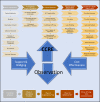The Wider Considerations in Closing Chronic Disease Gaps - Focus on Heart Failure and Implementation
- PMID: 35549873
- PMCID: PMC10201899
- DOI: 10.2174/1573403X18666220512160737
The Wider Considerations in Closing Chronic Disease Gaps - Focus on Heart Failure and Implementation
Abstract
Background: Heart failure (HF) is predominately a chronic disease. There are overlaps in HF and chronic disease research and care. Chronic disease and HF research are conducted with multiple goals. The overarching goal is "optimized patient outcomes at maximum costeffectiveness". However, observations on patients can come with many variables; thus, we see differences in clinical translation. This document discusses an argument for three important gaps common to HF and chronic disease, i.e., screening, self-management, and patient-reported outcomes (PRO), and provides a glance of how it could fit into the evidence tree. Pertinent arguments for a framework for health services and models of care are provided as a prelude to future consensus.
Methodology: 1) A preliminary literature review to identify a taxonomy for cardiovascular research, and 2) a review of the published literature describing the translation of research studies into clinical practice for cardiovascular disorders. A spectrum from observational to large randomized controlled trials to post-marketing studies were identified.
Discussion: A brief discussion on traditional research and differences focusing on screening, mixed methods research concepts, and chronic diseases models of care. Six steps to facilitate this: 1) Research design; 2) Research application (translation) i. routine ii. challenges; 3. Transforming research to translational level; 4. Funding and infrastructure; 5. Clinical Centres of Research Excellence (CCRE) and collaboration; 6. Governance and cost-effectiveness.
Conclusion: Implementation research that aims to link research findings to improved patient outcomes in an efficient and effective way is a neglected area. Skills required to perform implementation research are complex. Ways to maximize translational impacts for chronic disease research to clinical practice are described in a HF context.
Keywords: Chronic disease; clinical translation; health policy; heart failure; patient-reported outcomes; screening.
Copyright© Bentham Science Publishers; For any queries, please email at epub@benthamscience.net.
Conflict of interest statement
All co-authors have won independent and governmental research funding. None pose a conflict of interest for this review.
Figures






Similar articles
-
The future of Cochrane Neonatal.Early Hum Dev. 2020 Nov;150:105191. doi: 10.1016/j.earlhumdev.2020.105191. Epub 2020 Sep 12. Early Hum Dev. 2020. PMID: 33036834
-
Community-based care for the specialized management of heart failure: an evidence-based analysis.Ont Health Technol Assess Ser. 2009;9(17):1-42. Epub 2009 Nov 1. Ont Health Technol Assess Ser. 2009. PMID: 23074521 Free PMC article.
-
Enhanced External Counterpulsation (EECP): An Evidence-Based Analysis.Ont Health Technol Assess Ser. 2006;6(5):1-70. Epub 2006 Mar 1. Ont Health Technol Assess Ser. 2006. PMID: 23074496 Free PMC article.
-
Knowledge to action: Rationale and design of the Patient-Centered Care Transitions in Heart Failure (PACT-HF) stepped wedge cluster randomized trial.Am Heart J. 2018 May;199:75-82. doi: 10.1016/j.ahj.2017.12.013. Epub 2017 Dec 27. Am Heart J. 2018. PMID: 29754670 Review.
-
Australian nurses in general practice based heart failure management: implications for innovative collaborative practice.Eur J Cardiovasc Nurs. 2004 Jul;3(2):135-47. doi: 10.1016/j.ejcnurse.2004.02.002. Eur J Cardiovasc Nurs. 2004. PMID: 15234318 Review.
Cited by
-
Heart Failure Paradigms in the Developed World - A 'Taproot' Plan (Part 2).Curr Cardiol Rev. 2022;18(4):e130522204750. doi: 10.2174/1573403X18666220513122705. Curr Cardiol Rev. 2022. PMID: 35570514 Free PMC article. No abstract available.
References
-
- Krumholz H.M., Currie P.M., Riegel B., et al. American Heart Association Disease Management Taxonomy Writing Group. A taxonomy for disease management: A scientific statement from the American Heart Association Disease Management Taxonomy Writing Group. Circulation. 2006;114(13):1432–1445. doi: 10.1161/CIRCULATIONAHA.106.177322. - DOI - PubMed
Publication types
MeSH terms
LinkOut - more resources
Full Text Sources
Medical
Research Materials
Miscellaneous
